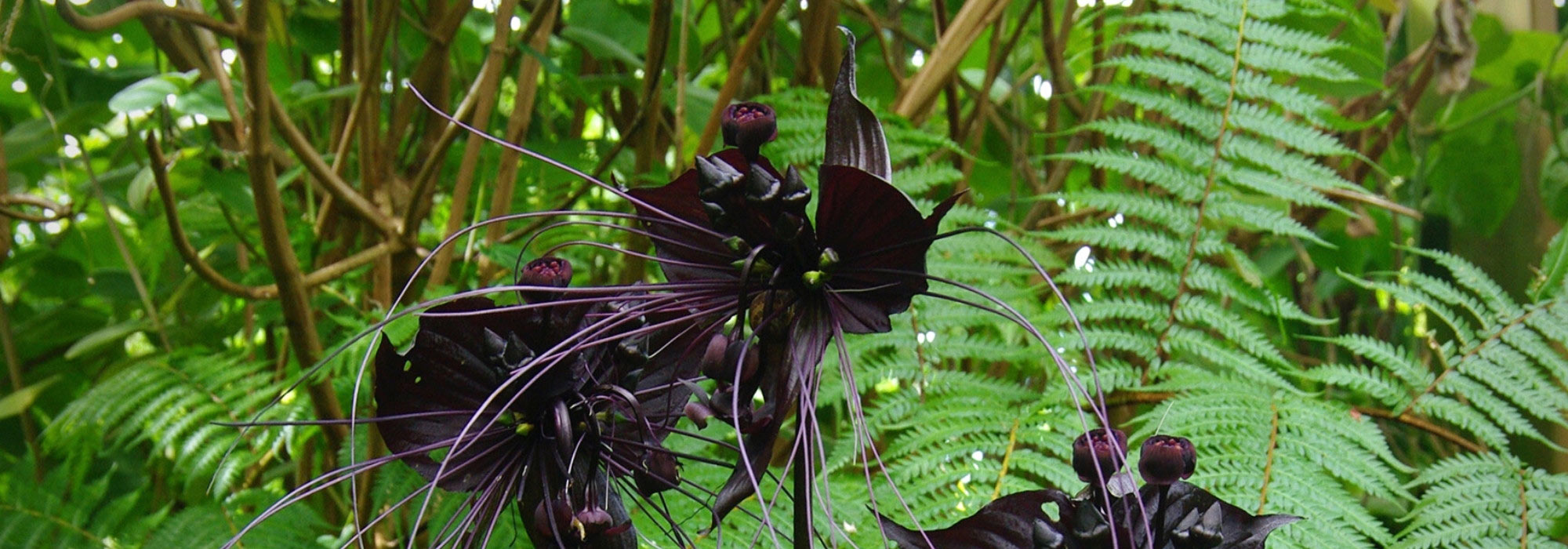
Tacca: planting, growing, and care
Contents
Tacca in a few words
- Tacca amazes with its spectacular inflorescences, reminiscent of bats in flight
- The flowers are borne on a stem that can sometimes reach over a metre in height, emerging from a lush clump of foliage
- In our climate, flowering occurs from June to August, approximately 2 years after planting
- Frost-sensitive and very tender, in our regions it can only be grown in a warm and humid greenhouse or conservatory
- It is ideal for those looking to add a touch of exoticism and originality to their indoor plant collection
The word from our expert
Tacca (Tacca chantrieri and Tacca integrifolia), known as the “Bat Flower” or “Devil’s Flower”, captivates with its spectacular flowers, in black, white, green, or purple, adorned with long filaments, evoking the silhouettes of bats. It blooms in summer and displays fascinating flowers, unique among plants. A delicate plant best suited for experienced gardeners, the Tacca requires protection from cold and scorching sun, thriving in a greenhouse or heated conservatory.
Suited for indoor cultivation in our climate, the Tacca needs specific conditions of warmth and humidity to flourish, along with attentive care. Its demanding nature is rewarded with blooms worthy of the Addams Family and lush foliage, making this plant a true botanical curiosity. Its dramatic appearance and ability to become a focal point in an indoor plant collection deserve your attention!
Discover also our range of rare and original bulbs.
Description and Botany
Botanical data
- Latin name Tacca sp.
- Family Taccaceae
- Common name Bat Plant, Devil's Flower
- Flowering June to August
- Height 70 cm
- Sun exposure Partial shade
- Soil type Acidic to neutral, moist, very well-drained, humus-bearing, fibrous
- Hardiness Frost-tender
Tacca, better known as the Bat Plant or Devil’s Flower, is a rhizomatous perennial belonging to the Taccaceae family, which consists solely of the genus Tacca. Native to rainforests and valleys in Southeast Asia and Northeast India, it can be found at altitudes ranging from 200 m to 1,300 m. The genus includes ten species, the most well-known and widely cultivated of which are Tacca chantrieri, and the Tacca integrifolia or White Bat Flower.
This plant grows relatively slowly from a thick rootstock, producing a dense clump of basal leaves about 50 cm tall. The oblong, lanceolate leaves, measuring between 20 and 50 cm, are borne on long petioles of 10 to 30 cm, sometimes tinged with purple. The evergreen, luxuriant foliage, with prominent veins, unfolds in a glossy green on the upper surface and a lighter shade underneath.

Tacca boasts lush, glossy green foliage
In summer, from June to August in our latitudes, and sporadically until December, the flower stem emerges from this leafy clump, reaching heights of 75 cm to 1.20 m, depending on the variety. Only Taccas aged at least 2 or 3 years will flower. The stems are sturdy and very rigid, smooth and leafless. These unusual flowers owe their common name to the appearance of their inflorescence, whose dark purple bracts, veined with green or even almost white, spread out like the wings of a bat in flight. The Tacca chantrieri is distinguished by striking umbels of deep purple, almost black, while the Tacca nivea displays white or cream bracts, sometimes tinged with green and veined with light brown, turning brown in the Tacca chantrieri ‘Green Isle’.
The intriguing, pendulous flowers consist of 5 petals and nestle at the heart of four large floral bracts, measuring up to 20 cm wide. They are grouped in clusters of up to 25 flowers. Each flower pedicel produces very long filaments, up to 30 cm, adding to the dramatic appearance of the flower, reminiscent of the tail of a shooting star.
After flowering, the flowers transform into fruit in the form of capsules containing flattened seeds that can be sown to propagate the plant.
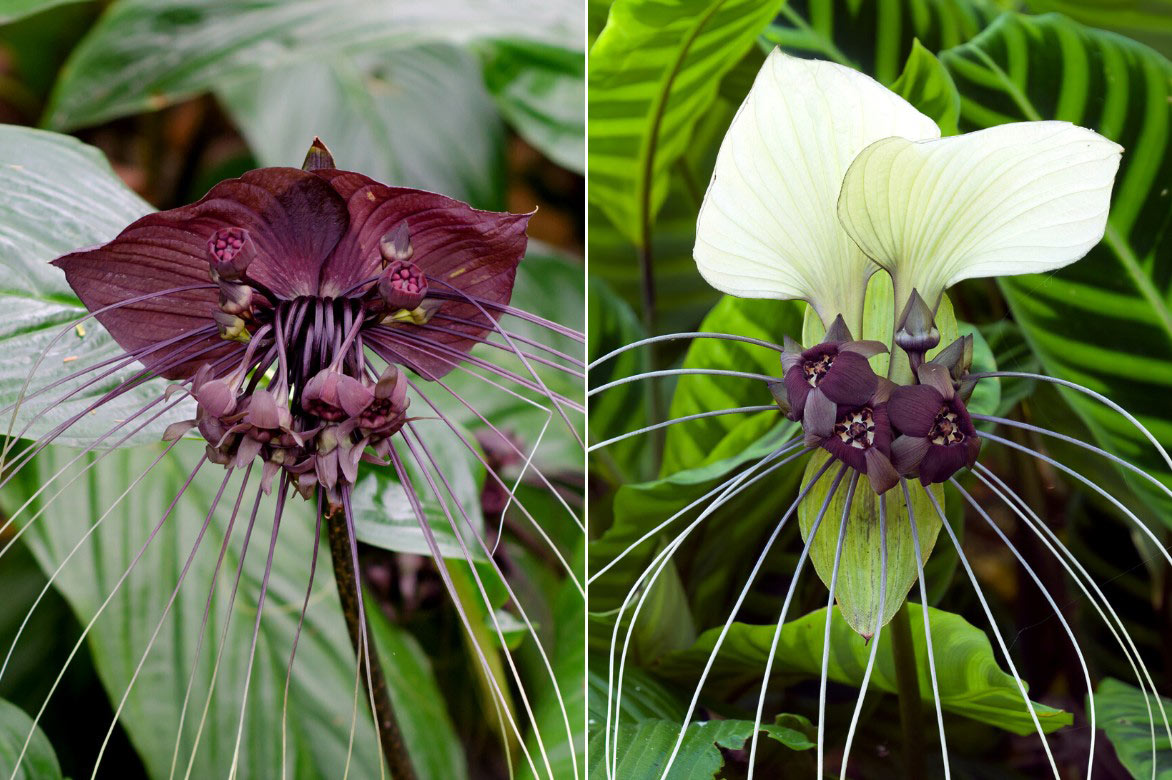
The flowering of Tacca chantrieri and Tacca integrifolia
Main species and varieties
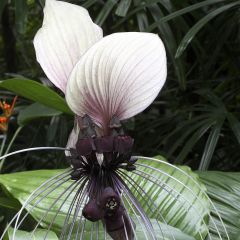
Tacca integrifolia Nivea
- Flowering time July to September
- Height at maturity 75 cm
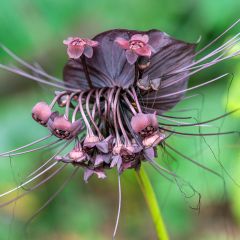
Tacca chantrieri
- Flowering time July to September
- Height at maturity 70 cm
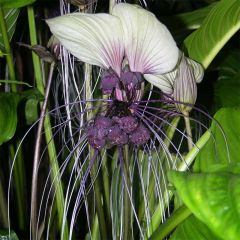
Tacca integrifolia
- Flowering time July to September
- Height at maturity 1 m
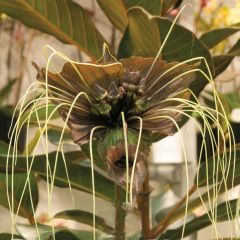
Tacca chantrieri Green Isle
- Flowering time July to September
- Height at maturity 70 cm
Discover other Tacca - Bat plant
View all →Available in 0 sizes
Available in 1 sizes
Available in 1 sizes
Available in 1 sizes
Available in 1 sizes
Planting the Tacca
Where to Place the Tacca?
The Tacca is a delicate bulbous plant to cultivate. It makes a perfect indoor plant, provided it is given suitable growing conditions, similar to certain orchids. Originating from tropical regions, it thrives in environments close to its natural habitat, meaning a tropical, warm, and humid setting with partial shade. In the wild, it is found in slightly damp and semi-shaded areas. From its origins, it has retained an extreme sensitivity to cold and a need for humidity. This frost-tender plant must be grown in a warm and humid greenhouse or in well-lit interiors, but without direct sunlight. It dislikes cold and may die below 12°C, as well as high temperatures that dry out the atmosphere. You can place it on the terrace or in the garden from June to August, in a slightly sunny spot sheltered from drafts. Ideally, it should be placed near a pond to benefit from the ambient humidity. This extravagant indoor, conservatory, or greenhouse plant will need to spend most of the year in warmth.
When to Plant the Tacca?
The Tacca is ideally planted at the end of winter, in February-March, to allow the rootstock enough time to establish itself and typically flower in early summer.
How to Plant a Tacca Bulb?
Prepare a very well-draining, slightly acidic substrate, such as heather soil.
- Use a large pot with drainage holes
- Spread a layer of clay pebbles at the bottom of the pot for perfect drainage
- Fill the pot with a mixture composed of one-third leaf compost, one-third crushed pine bark, and one-third coconut fibre
- Plant the rootstock with the growing point facing upwards. Cover it with soil, leaving the top part of the rootstock slightly exposed
- Place a saucer filled with water under the pot
- Water generously
- Position the pot in a bright spot, but without direct sunlight, and keep the substrate evenly moist
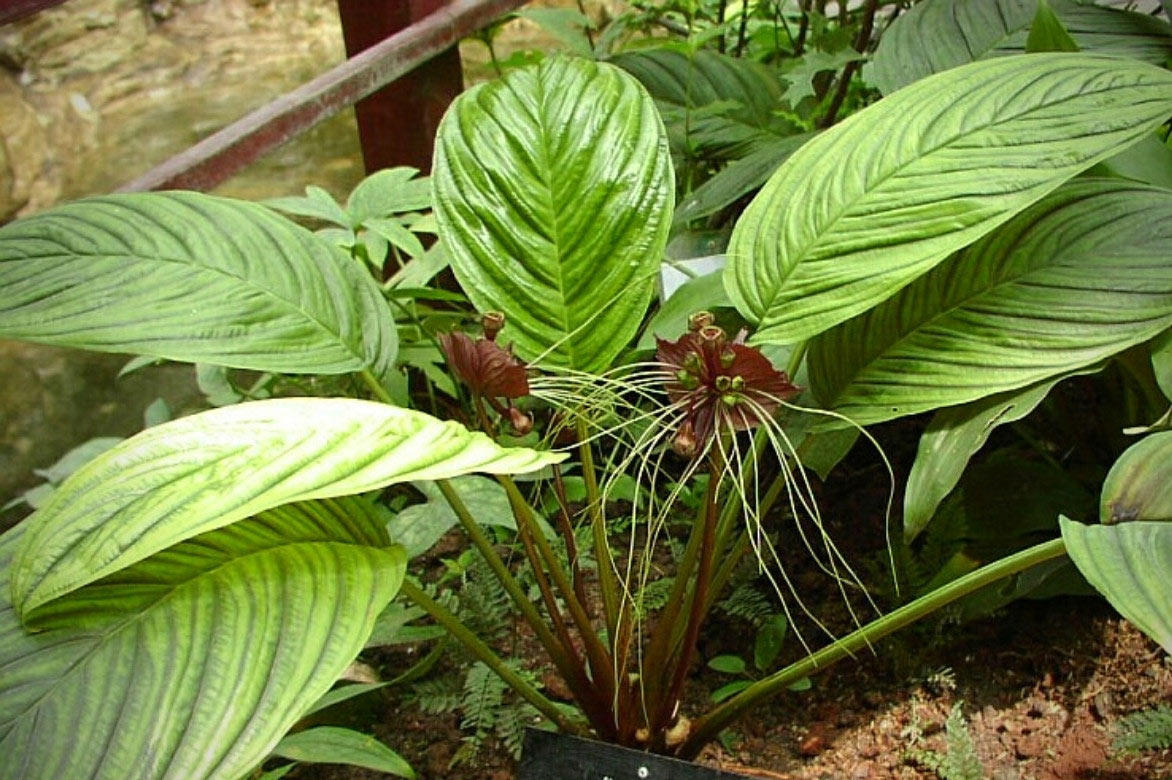
Maintenance and Care
The Tacca is a tropical plant with a sometimes capricious and demanding character, requiring specific growing conditions to thrive.
The Tacca requires high humidity. Regular watering, twice a week or more during flowering, with non-calcareous rainwater to keep the soil consistently moist but not waterlogged, is essential. The substrate should never dry out more than 3 cm on the surface. The Tacca is sensitive to stagnant water, so good drainage is crucial. During active growth periods, increase the watering frequency. It is helpful to mist the leaves with non-calcareous water (but not the flowers) or place it on a bed of damp clay pebbles to help it cope with dry air. In winter, slightly reduce water intake.
The optimal temperature for its growth is between 18°C and 25°C. Avoid cold drafts and temperature fluctuations. In summer, it should be placed at a temperature of 25°C to 30°C, and in winter, in a cooler spot, between 15°C and 18°C to respect its dormant period, which lasts about 2 months. However, it is entirely possible to move it outside once the temperature rises above 15°C. Proceed gradually, as a plant overwintered indoors must be slowly acclimatised to the outdoors. Place it in a spot where it will be shaded during the hottest hours and ensure it remains sufficiently hydrated.
A diluted fertiliser for heather soil plants added to the watering water is beneficial in summer, every two weeks to support flowering. Do not fertilise in winter.
An annual repotting in spring is recommended, using a slightly larger pot and a fresh mix of compost and perlite.
Diseases and potential pests of Tacca
Although the Tacca is relatively resistant to diseases, it can be affected by certain issues if the growing conditions are not ideal.
- Root rot: Caused by excess moisture, it can be avoided with good drainage and by avoiding overwatering the plant.
- Aphids and red spider mites: These parasitic pests can attack the Tacca, especially in hot and dry conditions. Spray rainwater regularly on the foliage to maintain a sufficiently humid atmosphere.
Multiplication of Tacca
The propagation of Tacca can be done in two ways:
By dividing the rootstocks
- In spring, the rootstocks, if they have multiplied, can be carefully divided and immediately replanted in pots to give them time to grow well
- Ensure each section has at least one bud
By sowing
The germination of Tacca seeds is a long and delicate process. Sow the seeds in a mixture of moist compost and keep them warm at a constant temperature of 25°C. Patience is essential, as germination can take several months.
Combine the Tacca
The Tacca, with its theatrical appearance, is difficult to pair with other plants. However, ferns, bromeliads, or flowering orchids grown indoors can complement its dramatic look and create a tropical corner or a surprising indoor plant arrangement. The Tacca will also look stunning when paired with the highly exotic foliage of arborescent ferns like that of Cyathea medullaris or Dicksonia antarctica. Also, consider the spectacular flowering of a strelitzia.

In a greenhouse or conservatory, you can pair the Tacca with lush foliage and exuberant flowering. Here, Cyathea medullaris, Strelitzia reginae, Passiflora vitifolia, and Tacca chantrieri (photo: Geoff McKay)
- Subscribe!
- Contents
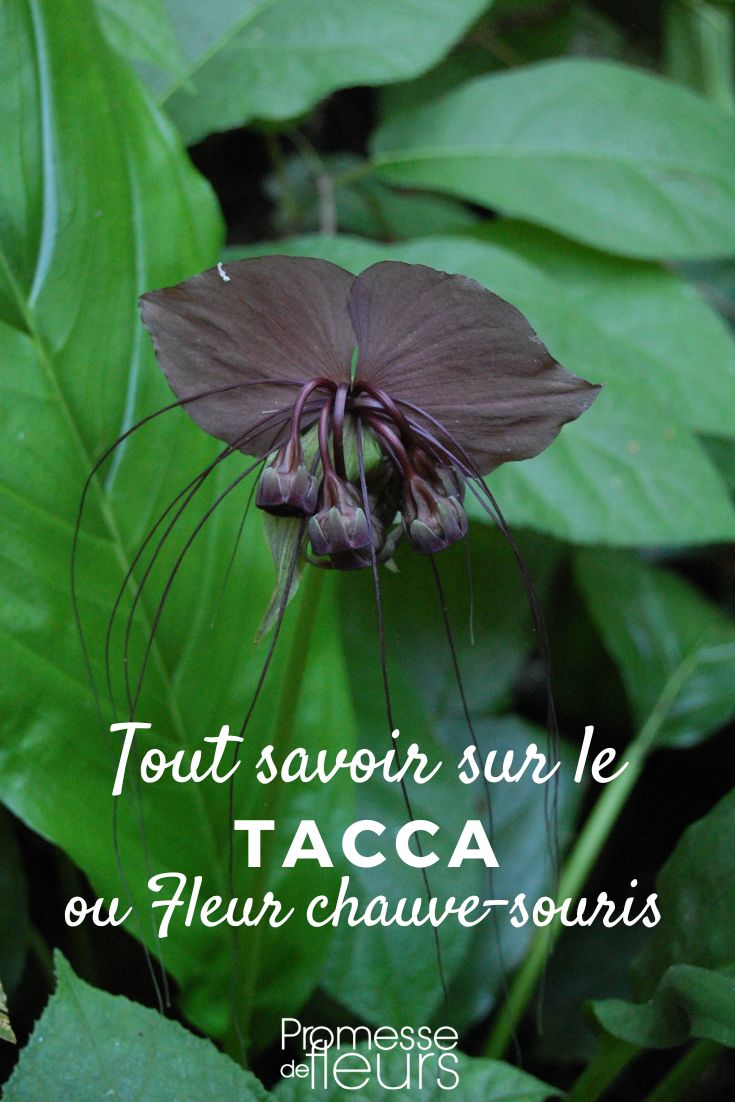































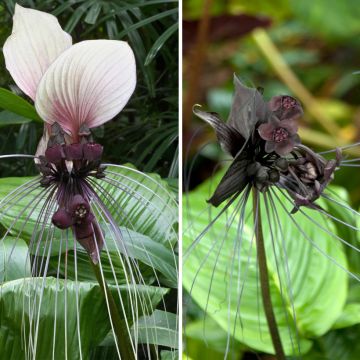




Comments